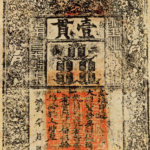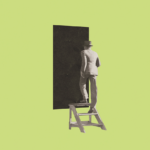Negative nationalism and the “deception dollar”
The object in the Ashmolean money gallery that I found most interesting was the 9/11 conspiracy theory money. The “One Deception” bill is a parody of a $1 bill that proclaims “In Fraud We Trust” and replaces each “1” with “9-11.” It is plastered with URLs for websites that raise questions, catalog information, or expound conspiracy theories about the 9/11 attacks. As I examined the deception dollar and explored the websites it linked, I was struck by how it prefigured the events of 21st century American politics.
The choice to present this information in the form of cash serves several purposes. The form of a dollar bill is easy to circulate. It serves to associate money with “War and globalization” (a phrase prominently displayed on the object). And its appropriation of patriotic symbols seems intended to provoke shock to grab attention. In addition to its uses in exchange, money is often an object of civil religion (Bellah 1967). American civil religion, Bellah argues, has its own prophets, martyrs, holy days, holy places, and symbols. Coleman (1996) claims that the prime assertion of American civil religion is that “a democratic United States is a prime agent of God in history.” By replacing these symbols with symbols of control and words such as “totalitarianism” and “fraud,” the object evokes a sense of “negative nationalism” (Robbins 1998) as “Make America Great Again” would a decade-and-a-half later. The slogan is a prime example of the temporal rhetoric of the American right that simultaneously looks to the past and future for escape from the constructed depravity of the present (Bialecki 2017). Though the bill does not explicitly moralize the past, it does attempt to demonize the present by association of the visage of Bush with “fraud” and “totalitarianism” and the placement of missiles and the Pentagon around the bald eagle. Its nod towards the future comes with the prominent display of the phrase “Project for a New American Century,” the name of a neoconservative think-tank that championed a hawkish response to 9/11. The future is not constructed optimistically. The negative nationalism evident in the deception dollar is a prototypical version of that which was effective in 2016, though the “Janus-faced temporality” (Bialecki 2017) that moves simultaneously towards the past and future had clearly not yet crystallized.
About half of the URLs lead to pages no longer about 9/11 conspiracy theories: the URLs are up for sale or taken by other organizations. The only indication of their past is on this deception dollar and the Wayback Machine. Most of the others lead to Web 1.0 pages that have rarely been updated since 2005. But there is one recognizable name: Infowars, the project of the infamous Alex Jones. Today, Infowars and Jones are strongly associated with the conspiratorial right. But the collection of websites presented on the deception dollar feel almost non-partisan by today’s standards. Even as they harshly criticize the Bush administration and federal agencies, there are not really positive endorsements of Democrats. The “deception dollar” website includes an updated version of the deception dollar that depicts Obama instead of Bush. The focus is on finding “the truth,” often through demonstrations or interrogating public officials of all party allegiance rather rather than electoral politics. But this milieu did not last forever; as the last website standing, Infowars has become strikingly partisan. The main headline on Infowars today is a video of a verbal gaff from Joe Biden. Jones has, at least for the moment, fallen in line with the Trump faction of the American right – endorsing him in 2016 and 2020 despite a falling out in 2018 (Hayden 2021). The inclusion of Infowars on the deception dollar is therefore also prescient. Conspiracies that allege a shadowy cabal whose goals are “globalization” and “totalitarianism” (as 9/11 conspiracies so often do) have been captured by more mainstream figures in the right.
The inclusion of the deception dollar in the Ashmolean is to contribute to the point that money can be a zone of political contestation. Other objects in the same display case include altered money such as “Lesbian Money” (see Bichen’s post) or Republic of China Yuan altered to serve as Hong Kong dollars in the immediate aftermath of World War II. Others serve the theme by depicting important political figures: Napoleon and Che Guevara. Another is a $1000 bond for a railroad company. Unlike the deception dollar is different to these other objects. It does not seem to have been intended for circulation as currency. Its relationship to “money” is, if anything, antagonistic. It not only imitates the image and demonizes symbols of a specific type of money but also many of its linked websites share the perspective that some group, somewhere, values profit over anything else. It therefore constructs money as a cause for suspicion and a symbol of ill-intent.
Citations in comment
Contributed by MaxWolf on 05/02/2023






